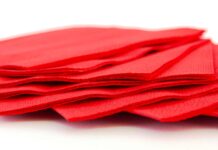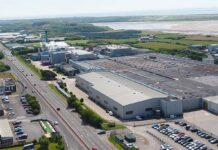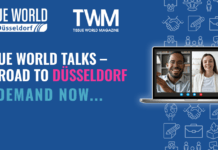We asked the world’s leading converting machinery manufacturers to explain where their R&D efforts are leading them for TWM’s annual Converting Technical Theme. Gambini, Futura, PCMC, Maflex and MTorres responded.

What events in 2015 have had the biggest impact on your business and why?
Carlo Berti, sales and marketing director of Gambini: “In 2015, our technological innovations have attracted the interest of major multinational companies that have chosen Gambini to improve their flexibility and increase production capacity. For us, it is a great award that repays the work of research and development and gives us confidence for the future.”
Piero Ceccon, head of sales and ProCare, VP international operations at Futura: “For us it has been the launch during It’s Tissue of the Andromeda Concept which has generated significant business for Futura. Looking at external influences, however, it is the vertical integration of a number of pulp producers that have chosen to bring tissue within their portfolio. The motivation for taking this step into converting is that tissue is certainly an attractive business within the paper sector, and the desire to add value is also a driving force. The common theme is that all these new players are looking for high performance and quality. They also want solutions which integrate this high performance across their business and which are ready for the opportunities presented by Industry 4.0.”
Sergio Casella, president and chief executive of Paper Converting Machine Company Italia: “Last June, we opened our doors at It’s Tissue and hosted hundreds of customers and showed our latest innovations. It was a big and fruitful occasion to create a direct relationship, not only with the sales team and customers, but also a meaningful experience for the entire PCMC team.”
Joseph Gotshall, North American sales director – Tissue, MTorres: “We have been working on some new developments in the converting of structured tissue, and lightweight non-wovens that have had great impacts on productivity. Because of these developments we have been able to sign new clients in new markets. Many of those initial contacts came to us through referrals from people we have met over the years by attending Tissue World, which we always see as a pinnacle event for our success and our brand. So Tissue World has helped in us connecting with new market niches as well as allowing us to connect with a number of existing partners all in one place.”
Martin Kyles, chief executive Maflex America: “We’ve been steadily gaining market share globally over the last several years, while maintaining our core customers with several of them having multiple Maflex machines. This has also been true in North American with both our small to mid-sized customers and large multinationals. In 2015 we saw a huge spike in customer confidence of Maflex as a reliable machinery and service provider. This was made evident by many of our existing customers making multiple purchases of both full converting lines and various converting components. This increased confidence also resulted in increased sales to new customers who witnessed our existing customer’s success stories.”
Will 2016 and beyond see you targeting business in emerging markets in particular, or will focus mainly be on developed economies?
Berti: “Our offer is mainly addressed to mature markets where there’s the need to renew technology through the introduction of new lines or retrofits able to deliver a quantum leap.
“However, our lines are designed to increase competitiveness and to gain market share in all contexts. Our focus at the moment is concentrated on North America and Latin America areas, where growth or reorganisation prospects can be identified.”
Ceccon: “We are present with installations world-wide, from Oceania to North America, and we target businesses which are willing to innovate, no matter where they are located.”
Casella: “We will continue to work with emerging markets but the priority is certainly the developed economies. We are well known there and receive appreciation from customers and a continuous flow of repeated orders.”
Gotshall: “MTorres´ business is global and we do have projects in emerging markets. However, since we focus on high end customised solutions for adding automation to web handling processes in the tissue industry, non-wovens, and the allied paper industry, we see a large portion of our revenue coming from well developed economies.”
Kyles: “We are committed to growth in emerging markets. We feel our diverse product offering allows us to be competitive in these markets. Our simple, yet flexible designs are a perfect fit. We will also continue to focus on our growth in the developed economies.”
What latest automation features are improving productive efficiency? Do you have any case study examples?
Berti: “Gambini features some components that we have defined “efficiency boosters” because of their ability to increase productive efficiency through the introduction of automation in different points of the converting process. The Embosser TouchMax is the highest point of the technological improvement that we offer in terms of efficiency, safety, production speed and quality of the finished product.
“However, we can also mention other examples: SmartCut is a quick and smart Coremaker; CleanSeal is a system for the optimisation of the tail sealing that saves glue and creates a perfect and clean seal; FourFast is a four-lane accurate and reliable log saw with a minimum trim.”
Ceccon: “The Andromeda Concept, thanks to a new-to-the-market integrated parent reel handling system, can load, unload and splice with exceptional automation and safety, therefore delivering process continuity. To give one example, Andromeda Concept offers, for the first time in this industry, a technology which can position the jumbo roll (up to 3m diameter) on the unwind stand at the beginning of the converting line without manual intervention, including automatic chuck removal and insertion, and this offers considerable benefits in terms of safety and overall process efficiency.
“If the converting plant has an automated warehouse with laser guided vehicles (LGV) then the system will effectively be automated from the collection of the jumbo roll in its warehouse location to the winder and beyond, depending on the further processes specified, such as wrapping, handling and palletising. The Andromeda Concept is thus an indispensable part of the fully-automated mill, which is the ultimate solution for safety, productivity and efficiency.”
Casella: “Flexibility is one of the key factors for efficiency and all our recent innovations follow this concept. Customised solutions enable quick changes in production parameter and product characteristics. Our innovative rewinder AMICA UNICA has been developed to consider the continuous market changes and is the only rewinder with the DoubleGeometryTechnology, which allows two different type of products to be processed perfectly (consumer and AfH), with no compromises (from 90mm to 350mm of roll diameter).
“We have also focused our energy at the line upstream, finding solutions to adjust parent reel formats, unwinding units with automatic flying splicer and to increase the productivity and reduce downtime.
“Our attention is also on the packaging; in fact PCMC Packaging offers Advanced Simulation that identifies optimum line layout configuration for custom production needs. The simulation identifies potential bottlenecks up front to avoid surprises at startup. Our Advanced Line control techniques provide the means to automatically balance production rates across the pack loop based on the current state of each asset in the process. The system constantly evaluates the production process and makes necessary steps to insure consistent production (minimising process stops).”
Gotshall: “Our patented technologies on high speed splicing and tension control continue to provide efficiency increases to existing converting lines and are always a vital part of any high speed structured tissue converting line. In recent case studies we have seen an overall factory performance increase in multiple production lines when an MTorres system has been added to just one line. Since the line can absorb all of the inconsistent product or parent reels with multiple factory splices in it, all of the perfect reels can go to the other lines. This therefore allows multiple lines to each improve even when our clients have only invested in upgrading one.”
Kyles: “We have been designing increased finished product specification ranges with our push-button/tool-less change overs. This allows our customers to save time when making large scale changeovers. This also allows the operators to change the machines over quickly, without the need for maintenance and changeover crews.”
What new ways are you ensuring that the quality of cut is consistent?
Berti: “Gambini Log Saw ensures an optimal cutting quality thanks to the “stationary” cutting system. Our commitment is directed to the implementation of new technologies that can improve further to maximise performance and flexibility in this critical step of the converting process.”
Ceccon: “The key to Futura’s patented cutting technology, UTILITY, is higher efficiency, supreme finished product quality along with reduced waste – it has been a game-changer for the industry. Thanks to the smaller trim width which the UTILITY system achieves, more tissue is left to make into product. In certain scenarios it is even possible to make one extra roll out of each log produced and the disruptive presence of trim downstream has been eliminated. Consistency is thus guaranteed.”
Casella: “Keeping the blade sharp is the key to cut quality, and recently we have invested in improving our grit evacuation and grinder wash-up technologies, in both our at-home and AfH logsaws. Cut quality begins at the Log Saw upstream, especially with waste-reduction efforts through reduced trim (“cookies”) length, a well-formed log all the way to the end is important to the consistency of cut quality up to the last cut in the log.
“We have also developed camera-based web edge guides which, when coupled with servo side-shift of the parent reel, provide the resolution to maintain good winding quality out to the end of the log.
“A further evolution of the well-known LSX, industrial Log Saw, is the recent smart re-designed industrial Log Saw with two channels, LSX². LSX² allows for the cut of industrial logs on two channels with a clamp changeover, to one channel, in less than five minutes.”
Gotshall: “The best way to ensure that we have a good quality consistent cut is to handle the web tension properly allowing our knife edge to shear through the web without tearing. We use cutting during our splicing process in order to create a good clean cut of the terminating web, which we can then splice to a new parent reel. This allows us to keep the running web and keep the process uninterrupted. We use a festoon system and a servo driven dancer to absorb any system upsets and maintain a perfect web tension. Maintaining a consistent tension is key in creating a clean cut that can be used to create a butt splice or a small overlap splice without a tail.”
Kyles: “Cut quality is an area where we have spent a large amount of time and energy in the past several years. The attributes we feel allow us to ensure a consistent cut quality are our precise control of the blade and orbit speeds and our ability to accurately detect and control the blade temperature.”
What features are you incorporating to minimise downtime between changes in print design, embossing design or roll format?
Berti: “We have always given great significance to reducing the machine downtimes during product changeover.
“Our embosser TouchMax has five steel embossing rolls always on board and enables product changeover in three minutes, which is fully automated and safe with all adjustments carried out via HMI panel. The TouchMax.Large works paper widths up to 3,600mm and creates equal conditions of maximum efficiency during product changeover, as well as multiplying the production capacity depending on the high working speed.
“Additionally there is VariDeck, the first lamination group that allows the customer to vary the width of the laminable paper in few seconds without replacing cliché roll and/or sleeve.”
Ceccon: “Our Infinity printer, JOI embosser and Sferica Rewinder have set industry benchmarks in terms of the time it takes to change sleeves and rolls to achieve different print designs and embossing patterns and roll specifications for finished product. This combination of technologies is ideally set up to achieve the best possible quality for conventional, structured and TAD tissue. But what is often overlooked is the time then required to set up the line in accordance with the new printed design, embossing pattern or roll specification – in other words, the “paper to paper” time. In this respect we have redrawn the boundaries thanks to global process control where the change in one parameter is automatically accounted for by all the other parameters affected. This makes the whole process much quicker and more accurate.”
Casella: “Our attention is orientated towards the overall converting process, in order to also reduce other possible downtimes for adjustments along the whole line.
“Starting from reel unwinding (e.g. system for automatic reel change, adjustments of the unwinder side frames to accommodate different reel formats), following the converting process, automatic on-the-fly adjustments of laminators, thanks to our Forte rewinding technology it is possible to maintain the embossing caliper retention from the first to the last sheet.
“PCMC Packaging has introduced closed-loop motorised adjustments to provide quick and repeatable change from format to format. Closed loop positioning insures that operators can quickly restore machine settings to proven recipe values. Changeovers are choreographed via operator interface screens that provide step by step instruction with operator verification.”
Gotshall: “Our high speed splicing technology allows continued production without stopping for reel changes. We have developed technology that is being used in printing processes that allows us to execute a perfect butt splice to proceed through the line. The butt splice has no web overlap so print heads can remain engaged with no lost time and minimal waste even as the splice goes through the line.”
Kyles: “We have designed both our entry level and higher level machinery with the capability to change all embossing, laminating, and print rolls quickly. Our rolls are designed to facilitate the quick change over as well. We have incorporated roll storage into the line layouts for customers who have limited space or ability to easily move the rolls into the converting line area. Our machines also have recipe based change overs which allow the finish product attributes (sheet count, perforation length, log diameter and core diameter) to be changed with a push of a button.”
Identify one or two areas of technology in which your converting systems really stand out.
Berti: “Our converting lines represent concretely the concept of “Perflexion”, the philosophy that inspires our R&D towards the achievement of real benefits in terms of performance, intended as a combination of production speed and quality of the finished product, and flexibility throughout the process. The aim of Gambini is to introduce technological innovations that improve efficiency, enhance safety, simplify operators’ work and, last but not least, optimize the final result.”
Ceccon: “Global process control is at the root of our Andromeda Concept and the integrated performance it promotes enables Futura’s technologies to stand out. It allows the line to benefit fully from sector-leading automation which goes hand-in-hand with safety. It also promotes optimum overall equipment effectiveness (OEE) and for the first time creates a converting line which is effectively one entity rather than a series of components.
“Two examples of technology which exemplify the stand-out nature of the Andromeda Concept are Sferica and Duplex.
“The Sferica Rewinder provides outstanding performance with the smoothest operation and consistent, unbeatable winding quality for conventional and structured paper. Maximum uptime and bulk preservation are key achievements of Sferica, while its patented Wind & Seal technology makes the external tail sealer redundant as the logs leave the rewinder perfectly sealed with minimum glue application thanks to new technology that doses from above, which is an extremely effective way to tackle glue dust contamination.
“Duplex is Futura’s double-head, high performance coremaker. It is this, combined with the new core accumulator, which are the essential components of the Andromeda Concept’s space-saving layout – a revolutionary feature. Thanks largely to the integration of the core-making and accumulating aspects of the line, these do not take up the space next to the line which standard arrangements require. This allows two lines to fit within a width of 25m – which is significantly less than would normally be the case – up to 43m would be quite typical. The smaller building footprint trims down the capital expenditure aspect of a project and simplified logistics and handling yield manpower savings.
“It is an essential aspect that the whole line is supported throughout its life by ProCare tools which provide for the effective startup, global control and maintenance of the line.”
Casella: “Our Forte rewinder is the actual flag of PCMC technology in terms of flexibility, safety, product quality and productivity.
“PCMC has also been honoured with the 2015 Manufacturing Safety Excellence Award by Rockwell Automation. This award recognises our dedication to providing the marketplace with safe equipment as well as the safety education and discussions about it with customers in order to increase their awareness and level of safety within their organisations. Among the nine organisations that received this award in the last three years, we are only the second OEM to be recognised. Looking at the other recipients such as GM, Pepsi Co, Procter & Gamble, Clorox, Goodyear, and Kimberly-Clark, we feel honoured to receive this prestigious award.”
Gotshall: “Tension control is our key factor of differentiation. We take web handling as our greatest task and can provide a consistency (even with highly variable material) that allows our clients to take advantage of more consistent production without stopping or slowing. High-speed splicing allows us to provide consistency even when we are moving from one reel to another.”
Kyles: “One stand-out area our customer’s benefit from is flexibility. By making our lines flexible, our customers can produce a wide variety of products on the same line when needed. The other area where we feel we stand out is our simple design strategy which results in ease of operation, lower maintenance and higher reliability. Both of these value added attributes directly impact our customer’s bottom line.”

































